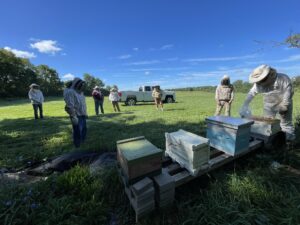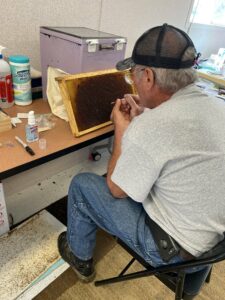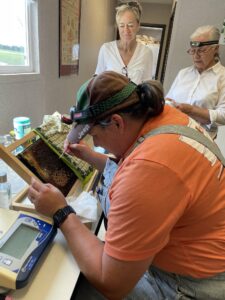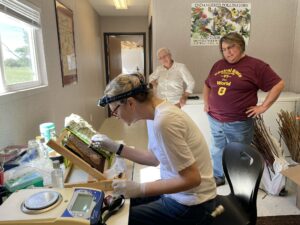Progress report for LNC21-459
Project Information
Wild feral honeybee colonies are one of the best local resources for improving the genetic diversity of honeybees. It is important to educate bee farmers about queen rearing and utilize local resources for sustainable apiculture instead of importing thousands of packages of bees with pathogens and parasites in the United States. The quality of the queen of a honeybee colony is essential for survival. Based on our data, feral queens tend to live longer than commercial queens. We hypothesized that feral queens may tolerate oxidative stress by living longer.
By comparing feral stocks with commercial package colonies, the aims listed below will be achieved:
1) to reveal the quality of flight ability and mating ability, we will compare the flight abilities of virgin queens using flight mills in the lab;
2) to analyze levels of oxidative stress of queen pupae using physiological assays;
3) to reveal the difference in the population, we aim to investigate the genetic variation among different queens, worker, and drones via single-cell sequencing technology with the best accuracy;
4) to educate bee farmers on queen rearing and grafting, the Central State University Research and Extension programs provide hands-on workshops in 2023 and 2024 and customized classes (webinars and field day) on queen grafting, genetic diversity, and queen disease;
5) to work with Purdue University (1862 Land-Grant Institution) and regional queen breeders to select mite biters, and
6) to train minority students on pollinator health and agricultural research. We work with beekeepers and queen breeders from eight different states (OH, IN, IL, MI, WI, WV, KY, and PA.) for queen breeding efforts.
CSU agricultural and natural resources extension supports farmers in using feral bees with high grooming & mite biting behavior. This research and education program provided by an HBCU and 1890 Land-Grant Institution will improve the genetic diversity of honeybees significantly for the North Central Region. By using local resources of feral colonies, we aim to improve environmental quality by reducing the risks of new pathogens and parasites from importing honey bee colonies to Ohio.
Our objectives/outcomes are:
1) test the flight abilities of virgin queens to achieve the outcome of the knowledge in the flight ability;
2) analyze levels of oxidative stress of queen pupae;
3) identify new transcriptomic variation among different castes;
4) to provide field days and work with regional queen breeders on instrumental inseminations and breeding for mite-resistant/mite-biter stocks;
5) to organize hands-on workshops and field days for local beekeepers to learn about grafting and queen rearing; and,
6) to train under-represented minority students on apiculture, pollinator health, honeybee genetics, and breeding.
For the year of 2022, we have started the grant as the first year. As to the objectives/outcomes, we have worked on establishing a protocol to test the flight abilities of virgin queens, hired a postdoctoral researcher to work on the genomic variations of queens for breeding; provided a field day with regional queen breeders on instrumental inseminations and breeding for mite-resistant/mite-biter stocks; organized hands-on workshop and field day for local beekeepers to learn about grafting and queen rearing; and trained 2 CSU students on apiculture, pollinator health, honeybee genetics, and breeding.
For the year of 2023, we have established a lab protocol for the flight ability experiments, and equipped with 6 flight mills in the molecular lab and 4 mills in our field lab. As to Objective 1, CSU Student Kristan Major has established a protocol for testing fly abilities of virgin queens. The comparison is between virgin queens handled before instrumental insemination (II) and after II.
|
Group |
Distance |
Total Time |
Halt Time |
Flying Time |
Mean Velocity |
Velocity Max |
|
Non-Inseminated Queen |
90.1637m |
340.814s |
13.128s (4) |
327.686s |
0.13793m/s |
0.521 |
|
Inseminated Queen |
63.7743m |
481.898s |
38.467s (3) |
443.431s |
0.14314m/s |
0.44248 |
She also collected data and tested 6 queen bees between high and low biting colonies of CSU stocks.
|
Group |
Distance |
Total Time |
Halt Time |
Flying Time |
Mean Velocity |
Velocity Max |
|
Low Biting Queen |
240.332m |
580.295s |
33.385s |
546.91s |
0.40193m/s |
0.45073 |
|
High Biting Queen |
12.8805m |
339.263s |
559.036s |
-219.773s |
0.09349m/s |
0.45663 |
|
Group |
Distance |
Total Time |
Halt Time |
Flying Time |
Mean Velocity |
Velocity Max |
|
Low Biting Workers (Trial 1) |
119.381m |
5359.04s |
37597s |
-32238s |
0.22658m/s |
0.44624 |
|
High Biting Workers (Trial 1) |
140.743m |
51.5s |
77964.8s |
-77913.3s |
0.35666m/s |
0.77757 |
|
Low Biting Workers (Trial 2) |
878.215m |
85215.7s |
483.591s |
84732.1s |
0.30881m/s |
0.67273 |
|
High Biting Worker (Trial 2) |
530.615m |
11676.5s |
3814.92 |
7861.54s |
0.27799m/s |
0.81178 |
For Obj. 3, the postdoctoral researcher supported by the fund has worked on optimizing the lab protocols of tissue dissection and lib prep of single-cell sequencing protocol in 2023, and has established a good protocol for lab members.
For Obj. 4, We held the 2023 workshop and field day with HHBBC and regional queen breeders on instrumental inseminations and breeding for mite-resistant/mite-biter stocks.
For Obj. 5, Our lab organized a hands-on workshop and field day for local beekeepers to learn about grafting and queen rearing.
For Obj. 6, Our lab trained 5 CSU students on apiculture, pollinator health, honeybee genetics, and breeding.
Cooperators
Research
Queen bees from high grooming stocks have a set of genetic markers for selection, and different levels of oxidative stress and flight abilities compared to low grooming or commerical stocks.
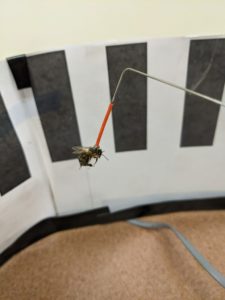
For outcome 1, we ask whether feral queens have better flight ability than the commercial package bees. Our lab has developed a protocol and a scientific publication for the method (Ma et al., 2019). Virgin queens will be evaluated using flight mills (Figure 1). As the glued bees on the mill, a computer connected to the flight mill sensor recorded maximum and mean velocity, flight duration, and flight distance. At least six virgin queens from each treatment (feral or commercial) will be used and each queen will be tested for six separate trial days. Feral stocks are from our university apiary. The non-selected commercial colonies are from GA and FL as controls. All flight mills will be located in the same room, with constant light (546.2±1.0 lx) and air temperature (25±1 ∘C). Six virgin queens per treatment group (feral queen vs commercial queen) will be used in this experiment.
For outcome 2, we ask whether the level of oxidative stress in feral queens is higher than the commercial bees. Queen pupae will be produced by our lab by grafting from two treatments (feral vs commercial) and collected for tests. Reactive Oxygen Species (ROS)- mediated oxidative damage will be quantified by measuring the Malondialdehyde (MDA) level in individual queen pupae (Li-Byarlay et al., 2016, Simone-Finstrom et al., 2016, Li-Byarlay & Cleare, 2020). The assay will be conducted using the OXItek™ Thiobarbituric Acid Reactive Substances (TBARS) Assay Kit (ZeptoMetrix Corp). The Pierce™ BCA™ Protein Assay kits (Thermo Scientific) will be used to measure the total soluble protein. Oxidative damage by normalized MDA levels will be examined in three biological replicates (colony). Each colony type (feral or package) includes at least six individual queen pupae (red-eye stage). Data will be analyzed using ANOVA.
For outcome 3, we ask whether we can identify new genetic markers for queen quality using cutting-edge technology. For whole genome amplification (WGA), we will use the Primary Template-directed Amplification (PTA) (Gonzalez et al., 2020). We plan to use twelve samples, six fertilized eggs (high mite biting stock versus non-selected commercial bees), and six samples of semen for instrumental insemination from two populations, prepare single-cell sequencing libraries by the 10x Genomics Chromium controller (Traniello et al., 2020). Downstream Illumina sequencing will be carried out at Ohio State University Sequencing center.
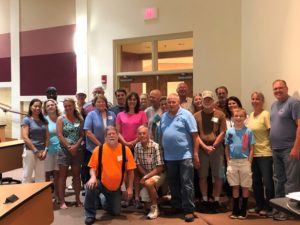
For outcome 4, we ask whether we can change more bee farmers on their view of local bee resources, sustainable queen rearing in Ohio. We aim to have a three-day workshop with about 33 participants each year on how to do grafting and queen rearing, how to make swarm traps and catch local feral stocks, and how to detect mite biting behavior traits using microscopes. Participating/trained bee farmers will receive a certification from Central State University. The picture on the left was our successful workshop from the previous SARE partnership grant. Figure 2 shows our 48-hr queen cell workshop organized in 2019.
For outcome 5, we plan to hold 4-5 day long field days with Purdue University and HHBBC each year on instrumental insemination events and work with queen breeders in the North Central Region to promote regional efforts on breeding for mite biters and mite resistant stocks. The field day event will be normally in May each year depending on drone and queen availabilities. Breeders will exchange genetics of queens from different feral colonies with high biting or chewing rate. Queen breeders will collect semen, conduct instrumental inseminations, and meet to discuss how to improve the breeding efforts as a group for our region.
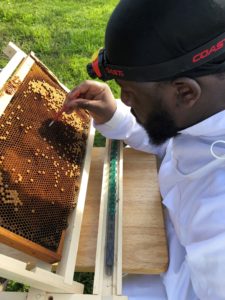
For outcome 6, we ask whether we can train more undergraduate students on honeybee genetics, genomics, physiology, and pollinator health. At least six students of the under-represented minority will be trained on the lab protocols to perform experiments of flight mill experiments, TBARS assays, and sequencing experiments. They will be the future workforce for sustainable apicultural and agricultural research. Figures 3 and 4 show examples of our student training for research. We have trained 13 African American college students (7 females) in the past three years.
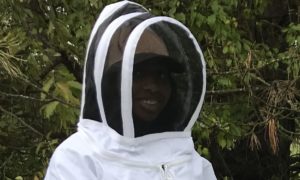
All the data and research results will be shared by research & extension publications, newsletters to the Ohio State Beekeepers Association, CSU extension and outreach activities (American Beekeeping Federation, State of Ohio State Fair, Farm Science Review, Ohio Ecological Food and Farm Association Conference, Black Farmer Conference, Minority and Women Small Farmers Conference, and local agricultural or farmer conferences).
Reference
Gonzalez, V., Natarajan, S., Xia, Y., Klein, D., Carter, R., Pang, Y., Shaner, B., Annu, K., Putnam, D., Chen, W., Connelly, J., Pruett-Miller, S., Chen, X., Easton, J. and Gawad, C. (2020) Accurate Genomic Variant Detection in Single Cells with Primary Template-Directed Amplification. bioRxiv, 2020.11.20.391961.
Li-Byarlay, H., Huang, M.H., Simone-Finstrom, M., Strand, M.K., Tarpy, D.R. and Rueppell, O. (2016) Honey bee (Apis mellifera) drones survive oxidative stress due to increased tolerance instead of avoidance or repair of oxidative damage. Experimental Gerontology.
Li-Byarlay, H. and Cleare, X.L. (2020) Current trends in the oxidative stress and ageing of social hymenopterans. Advances in Insect Physiology, 59, 43.
Ma, C., Zhang, Y., Sun, J., Imran, M., Yang, H., Wu, J., Zou, Y., Li-Byarlay, H. and Luo, S. (2019) Impact of acute oral exposure to thiamethoxam on the homing, flight, learning acquisition and short-term retention of Apis cerana. Pest Management Science, 75, 2975-2980.
Simone-Finstrom, M., Li-Byarlay, H., Huang, M.H., Strand, M.K., Rueppell, O. and Tarpy, D.R. (2016) Migratory management and environmental conditions affect lifespan and oxidative stress in honey bees. Scientific Reports, 6.
Traniello, I.M., Bukhari, S.A., Kevill, J., Ahmed, A.C., Hamilton, A.R., Naeger, N.L., Schroeder, D.C. and Robinson, G.E. (2020) Meta-analysis of honey bee neurogenomic response links Deformed wing virus type A to precocious behavioral maturation. Scientific reports, 10, 1-12.
We don't have the results to report yet.
stay tuned
Education
Project Activities
Educational & Outreach Activities
Participation Summary:
2/15/2023 New insights into the grooming and biting behavior of honey bees from the mandible transcriptomics, Kentucky Queen breeding Association workshop, invited talk;
1/18/2023 Genetics and Breeding of Mite-Resistant Honey Bees Stocks in Ohio and the Midwest, Central Ohio Beekeeper Association invited talk;
11/13/2022 Testing new physical control on Varroa mites in honeybee colonies Joint ESA/ESC/ESBC annual meeting Vancouver, Canada;
10/1/2022 How Do I Become a Bee Scientist: the ABCs and XYZs of Women Doing Bee Science, Bee Culture Conference, Medina, OH, invited talk;
4/25/2022 Mandibles from mite-biting bees: a multifaceted approach, Entomological Society of Ameria International Branch symposium virtual;
4/25/2022 Differences in Varroa Mite size: Feral vs Commercial Honeybees, Entomological Society of Ameria International Branch symposium virtual;
6/24/2022 CSU queen rearing workshop at CSU,
5/31/2022 Queen insemination field day, CSU campus, with Heartland honey bee breeding coop and Kentucky Queen Bee Breeding Association.
Project Outcomes
Bee farmers and beekeepers in Ohio learned how to do grating and queen rearing using local resources
Bee farmers and beekeepers in Ohio learned about the basic principles on how to do queen breeding
Bee farmers and beekeepers in Ohio learned how to make queen cell starter and finisher colonies.
